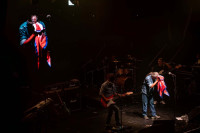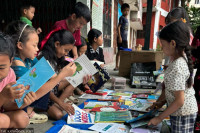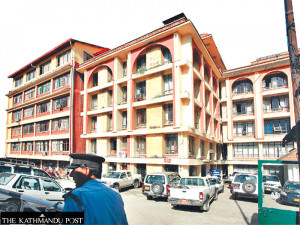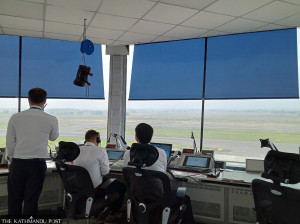Sat, Aug 30, 2025
Entertainment
Exploring, expressing
The Kathmandu University's BFA Exhibition Project at the NAFA Gallery presents a fascinating assortment of artworks pertaining to diverse themes and mediums
bookmark
Rachana Chettri
Published at : February 27, 2014
Kathmandu
February 20 was a big day for this year's KU Art School graduates, with their BFA Exhibition Project opening at Naxal’s NAFA Gallery, where Bhawana Ghimirey, Karma Chhetu Gurung, Nhooja Ratna Tuladhar, Pramesh Sherchan, Rabindra Kumar Shrestha, Rabin Maharjan, Roshan Sakha, Saran Tandukar, Sudeep Balla and Suresh Maharjan present an assortment of explorational expressive work:
Bhawana's Shakti, a collection of red-themed canvases, comes across as a young girl's attempts at figuring out and defining what femininity and strength mean.
Karma’s paintings explore the relationship between work-men/women and the tools with which they earn their living. My Work, My Pride, which depicts Nepali men and women—farmers, tailors, cobblers—as they go about their work, also comes across as an attempt to celebrate the toils of the 'working class'.
This Needs A Title, Nhooja's two-series short film is a more 'personal' exploration of life. Composed of 10 stories about “imperfect characters that (the artist) can relate to in certain ways”, the 30-minute film is a surreal exploration of life, its characters a strangely relatable collection of not-quite-so-everyday individuals. The people in Nhooja's film are always coming and going, often leaving behind only objects to validate that they were and they did.
Pramesh's attempts to make sense of life are represented in the form of monochrome cartoon panels where a devilish-looking cartoon version of himself can be seen trying to “live a utopian life in an imperfect society”.
In Rabindra's Line—The Soul Of The Universe, a collation with 20 artists, viewers get to the magic of subjectivity and individuality. A single meandering line that charts the same course over all canvasses has been turned into a procession of souls, a chain of thoughts, a struggle between clambering men, a train of heads and blocks of colour, among many other things, as Rabindra explores the potential of the humble line and also of human mind and expression.
As more lines and structures, forms and buildings populate Kathmandu, the city's old buildings get trampled upon, some lost altogether, and this is what Rabin explores in Transformation and Change. There is nostalgia in his art, even a hankering for the beauty of the past.
Roshan's work, Have Fun, is similarly linked with nostalgia but there is more joy in his paintings than distress. His many-coloured blocks are reminders of video games we played as children and also of the emoticons we have come to rely upon to evoke emotion in the era of terse text messages. There is no underlying social message the artist is trying to convey here which not only makes his work refreshing but also a whole load of fun.
There is as much colour and joy in Saran's work. Beauty in Unity, a collection of photos and video linked together by colour and cloth, follows Saran as he goes around Kathmandu and Birgunj bringing people together with his project. Faded bridges have been transformed into riotous celebrations of colour, a happy house covered with colourful pieces of cloth invite viewers to take a look and see the joys colour, community and coming together can bring.
Shiva's Deconstuction is more of an observation. The rapid urbanisation taking place in various parts of the country has left the artist wondering how long the beautiful hills and quaint villages of Nepal will remain unsullied by modern construction.
Shreejana has chosen to showcase her work with autistic and orphaned children in the form of t-shirt designs that take us all to the realms of childhood. Drawings that are part of Ingenious Sentiment make us wish none of us had ever given up on drawing. Even when we thought we were making crooked lines and disproportioned figures, we were expressing ourselves through a medium innate to human perception.
Sudeep's Song-Geet is as pop art as you'll ever see in Nepal. He has taken iconic images, lyrics and artists and used them as commentary on the ephemeral tendencies of the modern recording industry.
And Suresh has chosen to dwell on numbers. Numbers are not very appealing to a lot of people, they just don't speak to us the way words or pictures do. For someone like me, who knows little about the world of mathematics, Numbers is like a mysterious journey into space. The artist's beautiful abstract forms are visual representations of this mystery and his carefully studied, perhaps formulaically placed forms invite you to take a peek at the universe.
Today is the final day of the exhibition.
Editor's Picks
E-PAPER | August 30, 2025
×




 19.42°C Kathmandu
19.42°C Kathmandu












